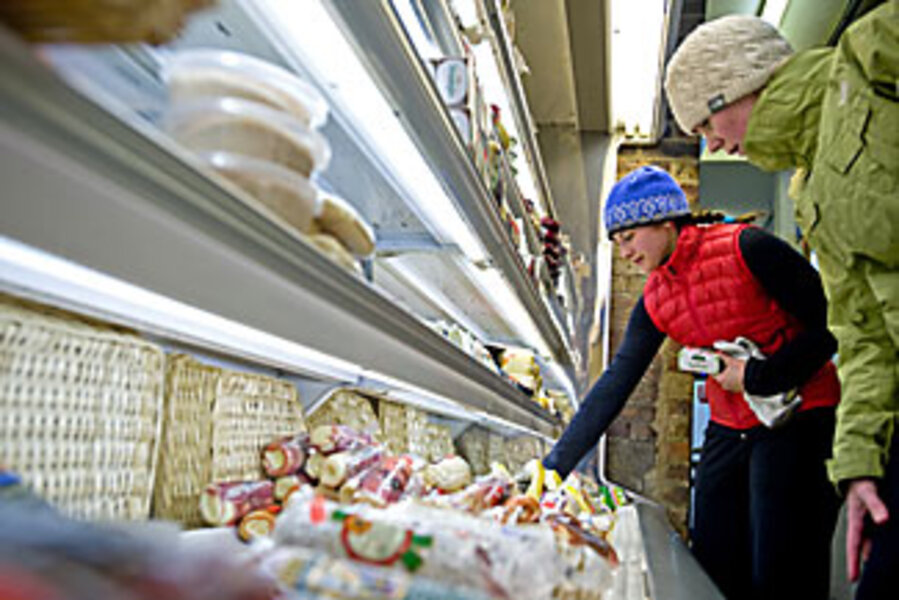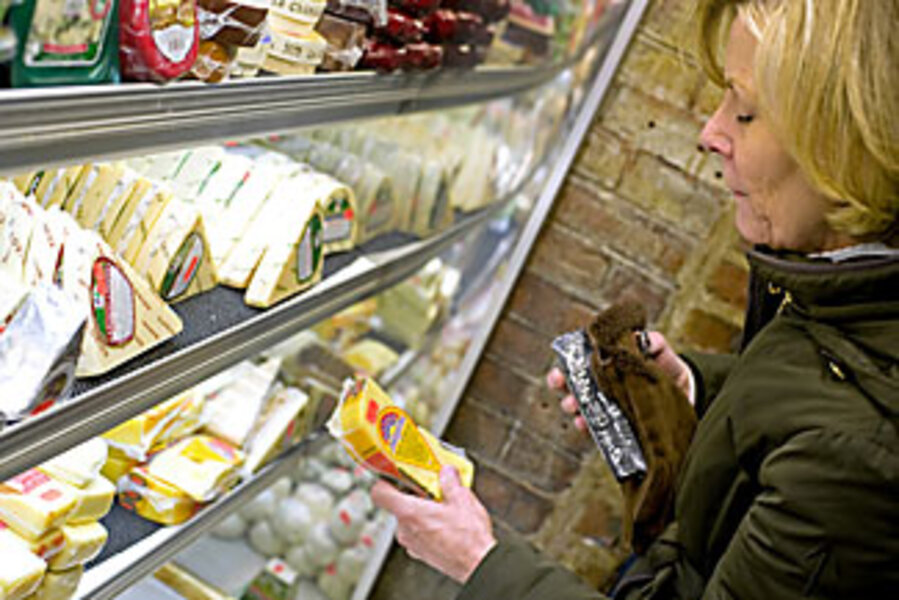Food prices ease, but thriftier shopping habits remain
Loading...
| Atlanta
Last summer's sky-high food and gas prices changed Brian Bintner's lifestyle dramatically.
The 20-something Atlanta nurse started taking the bus to work, stopped going out to eat, and supplanted his favorite food, Lake Superior perch, with cheaper Southern whiting.
At first, Mr. Bintner resented the intrusion of a topsy-turvy economy on his urbane existence. But now, even though prices are dropping, he's decided to stay his humble course: "I'm kind of enjoying eating at home, and doing my laundry afterwards."
Bintner's conversion from man-about-town to hearth-hugger explains, at least in part, why Americans – including the 3.6 million who lost their job in the last year – continue to trade down their eating adventures even as overall food prices declined for the second month in a row.
To be sure, the adjustment to recessionary foodstuffs like canned tuna and tagliatelle is an uncomfortable, even maddening, one for many Americans.
But with time being the sole luxury of the underemployed, downward pressure on raw food cost is part of a societal return to comfort grub and family sit-down dinners. Hence, farmers, food suppliers, and grocery stores are now scrambling to meet Americans where they eat.
"First you conclude you can't afford to go out to dinner, so you go to the store to buy a rotisserie chicken," says David Diamond, a grocery store consultant in New York City. "The next time, you realize that chicken was $5.99 and raw chicken is $2.99. How hard is cooking it anyway, particularly if you don't have anything to do this afternoon? It's definitely a short-term reversal of long-term trends."
From Houston to Boston, whole milk and chicken tenders are both cheaper today than a year ago. Sirloin prices are sliding. Feed corn – the anchor of the US breadbasket – is down by 20 percent or more in some states since last summer.
As a result, the percentage of New Yorkers concerned about high food prices has dwindled from 73 percent in July 2008 to 65 percent this month, according to the Siena Research Institute in Loudonville, N.Y.
Shoppers can expect the price of necessities ranging from margarine to M&Ms to flatten, even decline, as last year's 18-year high of 6.6 percent food-at-home inflation ratchets down to a more manageable 2 percent in 2009, says Ephraim Leibtag, an economist at the US Department of Agriculture's Economic Research Service in Washington. How much that will help stressed-out families depends on whether they have the extra time to take advantage of cheaper raw goods.
"In the extreme case of unemployment, there's definitely a substitution from convenience-added foods to more time-intensive ones where you spend an afternoon making dinner and buying ingredients," says Mr. Leibtag. "On the flip side ... maybe people are working as hard with equal or less pay and don't have an option to spend more time" cooking at home.
That stark reality is hardly comforting to those who've seen their prospects for both career advancement and rib-eye steaks diminish. Since he lost his job six months ago, Atlanta pipe fitter James Godfrey says hamburger and pork have replaced steaks and chicken in his grocery cart. "I can't afford to buy what I want anymore," he says.
Consumer concern is causing a fundamental shift in the food industry. "New habits die hard," warns the Progressive Grocer, a Nielsen Company publication that has tracked consumers' growing appetite for cheaper and more downscale meals.
Profits at corporate restaurant chains aimed at the middle class – think Applebee's and Ruby Tuesdays – are down by 10 percent in many parts of the country. Restaurants like McDonald's, meanwhile, are seeing orders rise. Local breakfast joints like Thumb's Up in Decatur, Ga., or Stone Soup Kitchen in Atlanta are reporting higher than usual orders of inexpensive comfort foods like fluffy pancakes.
"Everyone's trading down," says Mark Witte, an economist at the College of Charleston, in South Carolina. "People who would have had steak twice a week are having hamburger twice a week. People who would have had hamburger twice a week are having pasta every day. It's occurring for every economic group."
At Supervalu Inc., the Eden Prairie, Minn., food retailer that recently bought the Albertson's chain, managers are chasing customers with what could be called the "soup and coffee strategy" – limiting price promotions and instead lowering prices permanently on staples in order to influence consumer perceptions of where to get a good deal.
Supervalu CEO Jeff Noddle also reports that the best-performing stores are the ones that have been recently renovated, indicating that shoppers are increasingly treating a trip to the grocery store as a form of entertainment, or a refuge.
"We would expect that the overall demand for food won't change very much, and, indeed, food consumption at home may actually go up as people shift away from restaurants," says Daniel Sumner, an agricultural economist at the University of California in Davis.
Though thankful for the extra business, grocery stores still face squeezed profits as they make "price investments" to lower shelf prices in order to bring in cash-strapped consumers. A sign of the times: Sales of 98-cent "produce packs" at the Fresh & Easy grocery store chain are up 11 percent over the last year.
"If you're a consumer and have cash, deflation is the best thing that's ever happened," says Brian Buhr, an economist at the University of Minnesota in St. Paul. "The problem is, most consumers don't have cash."
Unemployed construction worker Robert Lee of Atlanta has one goal: to make do. After paying rent this month, he says he has $162 left over to spend on food for the next four weeks. At an Atlanta Kroger store, he found a 22-ounce can of mixed vegetables for $1. A jar of peanut butter and generic cookies rounded out his purchase.
"I have just enough money for one person if I shop wisely," he says. "I'm not going hungry just yet."








